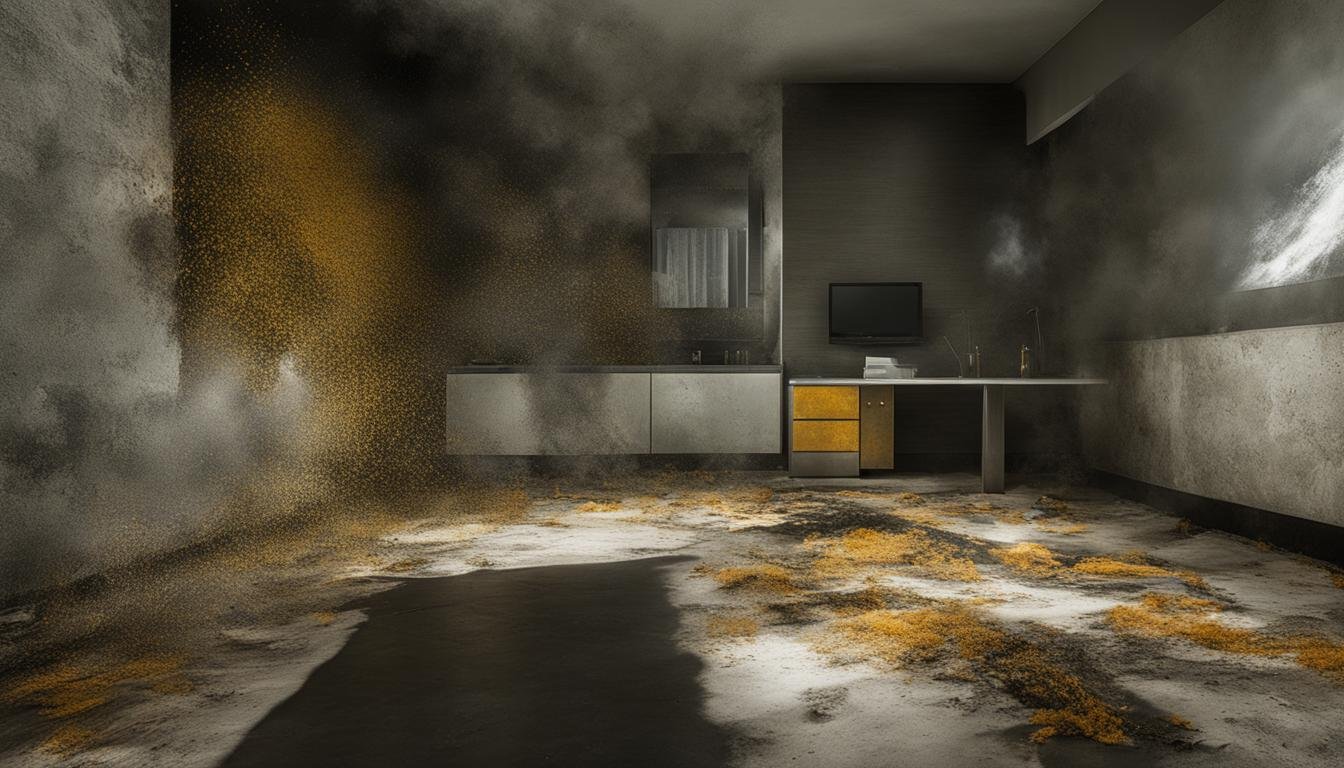Mold is a common issue in buildings and homes, especially in areas with high moisture. It can grow on various surfaces, such as paper products, ceiling tiles, and wood. The most common indoor molds include Cladosporium, Penicillium, and Aspergillus. Mold can enter homes through open doorways, windows, vents, and HVAC systems. Exposure to mold can cause a variety of health effects, including respiratory symptoms, allergies, and asthma. Certain individuals, such as those with allergies or compromised immune systems, may be more susceptible to mold-related health issues. To prevent mold growth, it’s important to control humidity levels, fix any water leaks, and ensure proper ventilation in areas like bathrooms and kitchens.
Key Takeaways:
- Mold is a common problem in buildings and homes, particularly in areas with high moisture.
- Mold exposure can cause respiratory symptoms, allergies, and asthma.
- Individuals with allergies or compromised immune systems may be more susceptible to mold-related health issues.
- To prevent mold growth, control humidity levels, fix water leaks, and ensure proper ventilation.
- Regular inspections and prompt remediation are crucial for addressing mold damage.
Signs and Symptoms of Mold Exposure
Mold exposure can have various health effects on individuals. It is important to be aware of the signs and symptoms associated with mold exposure. Some common symptoms include:
- Respiratory Issues: Mold exposure can cause respiratory symptoms such as coughing, wheezing, and shortness of breath. People with pre-existing respiratory conditions like asthma may experience more severe reactions.
- Allergic Reactions: Some individuals may develop allergies to mold, leading to symptoms like a stuffy or runny nose, itchy or watery eyes, and skin rashes.
- Occupational Hazards: In occupational settings with high mold exposure, workers may experience flu-like symptoms, fever, and fatigue, along with respiratory problems and shortness of breath.
The Institute of Medicine (IOM) has linked indoor mold exposure to respiratory symptoms and asthma exacerbation. While there is limited evidence linking other health effects such as memory loss or infant hemorrhage to mold exposure, further research is needed to establish these connections definitively.

It’s important to note that there is currently no blood test available to determine mold exposure. Allergy testing can only identify potential allergies to mold without pinpointing specific instances of exposure. If you suspect mold exposure or are experiencing any of the symptoms mentioned, it is recommended to consult a healthcare professional for proper evaluation and guidance.
“Mold exposure can have a range of health effects, from respiratory issues to allergic reactions. It’s crucial to recognize the signs and symptoms associated with mold exposure and take appropriate measures to address any potential hazards.” – Dr. Sarah Thompson, Environmental Health Specialist
Preventing and Remediating Mold Damage
In order to protect your property from mold damage, it’s important to be proactive and implement proper preventative measures. Regular inspections for water damage and visible mold are crucial to catch any issues early. If you notice any leaks, condensation, or flooding, address these conditions promptly to prevent mold growth. Maintaining humidity levels between 30% and 50% can help inhibit mold growth, so be sure to monitor and control moisture levels accordingly.
Fixing any water leaks in roofs, windows, or pipes as soon as possible is essential. After any flooding or water damage, thoroughly clean and dry the affected areas within 24-48 hours to prevent mold from taking hold. Adequate ventilation in areas that are prone to moisture, such as bathrooms, kitchens, and laundry rooms, is also essential. Installing exhaust fans and ensuring that clothes dryers vent outside can help minimize the risk of mold growth.
If you find extensive mold infestations in your property, it may be necessary to seek professional mold removal services. These experts have the knowledge and tools to effectively remediate the mold issues and prevent further damage. Regular indoor air quality testing is also recommended to identify and address any mold problems before they become severe. Additionally, consider using mold-resistant materials and removing or replacing any wet carpets and upholstery to further reduce the risk of mold growth in your home or building.
FAQ
What are the health risks associated with mold damage?
Mold damage can pose several health risks, including respiratory symptoms, allergies, and asthma. Individuals with allergies or compromised immune systems may be more susceptible to mold-related health issues.
What are the signs and symptoms of mold exposure?
Symptoms of mold exposure can vary but may include a stuffy nose, wheezing, itchy eyes, and in severe cases, fever and shortness of breath. People with pre-existing respiratory conditions like asthma may experience more severe reactions.
How can I prevent and remediate mold damage?
To prevent mold growth, it’s important to control humidity levels, fix water leaks promptly, ensure proper ventilation, and regularly inspect buildings for water damage and visible mold. If mold infestations are extensive, it may be necessary to hire a professional mold removal service. Regular indoor air quality testing can also help identify and mitigate mold issues.


